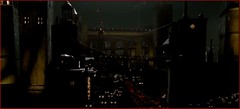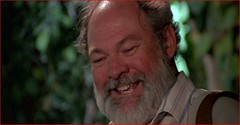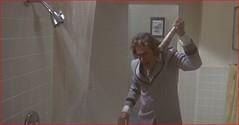
One of the first posts I imagined myself writing when I started this blog was an expansive essay on Vertigo. After picturing the myriad of messages, images and oddities my complete Vertigo essay would need -- not to mention sections on composer Bernard Herrman and his themes -- I became a little intimidated by my own expectations and backed off. Recently I compromised on a post that would try to list all the things I loved about the movie, but as that list evolved it became clear that one entry would be enough for one whole post, which I present today.
Vertigo enters my mind more frequently than any other movie. There's so much to like that I often find myself humming Herrman's Love Theme or just imagining the cemetery scene. It all comes back to The Chase, as I think of it: beginning with Scottie's first encounter with Madeleine at Ernie's and ending with the McKittrick Hotel scene. The chase sequence epitomizes what a cinematic experience Vertigo is and the decisions Hitchcock could make to brand his films so otherworldly and so uniquely his. The sound, the images, the story -- I'm in heaven when I watch it, and I'm going to try and explain everything that's perfect about it:
Ernie's
The Chase begins at the restaurant Ernie's, where Scottie is supposed to meet his mark, Madeleine. Ernie's is a great example to how committed Hitchcock was to making a complete environment in the Vertigo world: the restaurant set doesn't have much screen time and is not central to the plot at all, yet it becomes one of the most beautiful scenes in the most gorgeous movie of all time. The swanky Ernie's is covered rich crimson walls (looks almost like velvet) and filled with well-to-do San Franciscans. Ernie's is crowded, and yet when the camera pans into the dining room our eyes can't help but be drawn to the woman in the corner wearing a dark green dress. Her back is to the camera, but we all know it's Madeleine. She isn't even centered or focused on, yet because of the contrast in colors, it's apparent who we're supposed to be looking at.
Start your engines
No small detail is left to chance in Vertigo, including the cars of choice for Scottie and Madeleine. Scottie is driving a white DeSoto Firedome, while Madeleine is behind the wheel of a sea green Jaguar Mark VII. Watching Hitchcock, it's clear he was a car guy, as the automobiles in his movies are characters of their own (as I observed in The Birds, which features one of the rarest cars of its era). The Jaguar is a Union Jack touch in a movie that otherwise celebrates America, and also serves to set Madeleine apart while on the road, since almost all the other cars seen have nowhere close the elegance of her Mark VII. Scottie's DeSoto suits him similarly, as he's driving an obscure brand that would be dissolved only three years after Vertigo was released.
The early driving scenes lead us to a hallmark sequence of the film, as Madeleine turns off into an alley. The decision to have Madeleine enter from a backdoor in the alley not only serves to convey that she has done this quite a few times, but also enables Hitchcock to present a surprising reveal: Scottie opening the door from the dark alley to see a vibrant flower shop. This short scene of Scottie watching Madeleine purchase a corsage gives us two inventive techniques. First, the new DVD transfer of Vertigo allows us to better appreciate a subtle, yet brilliant bit of cinematography: there's such a contrast between the foreground characters and the floor, as well as from the foreground to the multiple planes of focus in the background, it's almost like a cinematic Where's Waldo. If you fix your eyes on the floor of the flower shop, it appears that it is the principle focus of the camera -- it appears sharper than anything else in the frame. This effect adds to the dreamy nature of The Chase, and is enhanced by the multiple planes of background that are still slightly in focus enough for us to observe their details. The other bit of brilliance in this brief scene is when we see Madeleine turn towards our (Scottie's) viewpoint -- we think she's spotted her pursuer, yet as the angle changes we see that she's actually admiring herself in a mirror. In this angle we see both characters looking at each other, even making eye contact, without Madeleine knowing he was there (or did she?).
See you in church
Throughout The Chase, Bernard Herrman's epic score has been pulling us through a variety of themes -- similar to how a silent movie score would, in that its many variances serve to further the story. As Scottie follows Madeleine into a church, we get a sort of Herrman/Hitchcock 'wink' through the score. When Scottie enters the church, the score suddenly switches to an organ playing a slow hymn -- the first reaction is that church is in session and the organist is playing, yet a split second later we see that save for our characters the church is dark and empty. What was originally presented as music in the story is revealed to be more of Herrman's atmospheric score -- a hymn whose ending note is played just as Scottie exits. I believe this maneuver to be a nod toward classic silent cinema, when the music would mirror where the movie was taking place (i.e. a maritime tune for a boat scene, a youthful jingle for children).
Scottie's exit of the dark church becomes another bold transition, as he finds himself in the adjoining cemetery, with blaring colors and gravestones that seem to glow in the light. Hitchcock uses the many flowers in the cemetery to play with perspective -- one such example is when Scottie is hiding behind a wall, when he begins walking again the camera pans with him and suddenly a rose branch comes into the frame right in front of the camera, and perfectly in focus. The Chase is so mysterious and suspenseful, Hitchcock's playful 'gotcha' jabs adds to its atmosphere.
Things only get more mysterious at the museum, where Scottie sees the resemblance between Madeleine and Carlotta. One aspect I recently noticed is how not only Madeleine mimics the painting, but also Scottie. Watch as Scottie turns to find the museum worker, at one point his face and eyes are in the exact same pose as Carlotta in the painting.
The lady vanishes
The Chase concludes at the McKittrick Hotel, home to the most vexing scene in the movie. The hotel itself fits right in with the rest of Vertigo's locations, as its dark gothic appearance looks out of place in the glowing streets of San Francisco. Madeleine's ghost-like exit is enhanced during Scottie's last glimpse of her in this scene, as he sees her raise the curtain in her room -- brightening up the grim exterior, resulting in a glow-like appearance for her. Hitchcock plays with perspective again here, as when Scottie is on the ground floor with the manager, the hotel interior seems small and narrow -- yet when he goes upstairs it suddenly looks grand and expansive, perhaps another minor jab at Scottie's fear of heights. We find Madeleine's room locked and undisturbed, despite the fact that we had just seen her open that curtain. It's a strange scene that doesn't really make sense even after later events occur, but it's a fitting conclusion to one of the most fascinating sequences ever seen.
Monday, February 05, 2007
Cut to The Chase
Filed Under Essays
Subscribe to:
Post Comments (Atom)












1 comment:
I learned quite a bit about Vertigo from this post! Even though I just watched it this past week I might have to go again already this weekend to try some of this newfound knowledge out...
Post a Comment